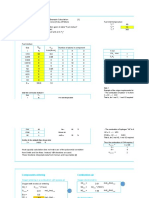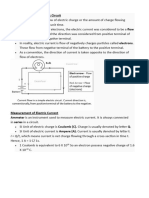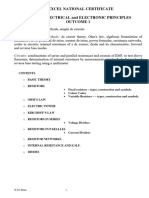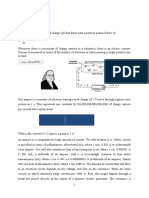Circuit Tutorial
Circuit Tutorial
Uploaded by
mick2560Copyright:
Available Formats
Circuit Tutorial
Circuit Tutorial
Uploaded by
mick2560Copyright
Available Formats
Share this document
Did you find this document useful?
Is this content inappropriate?
Copyright:
Available Formats
Circuit Tutorial
Circuit Tutorial
Uploaded by
mick2560Copyright:
Available Formats
In general terms, a circuit can be described as any group of electrical or electronic devices connected together by conductors.
Conductors are most often metallic, and wires were the conductor of choice in the past. Old radios and other electronic equipment were often a rat's nest of wires. Today, it's more common to find metallic pathways, often called traces, on a board constructed of a mixture of fiberglass and epoxy. The terms board and card are interchangeable. A schematic in electronics is a drawing representing a circuit. It uses symbols to represent real-world objects. The most basic symbol is a simple conductor, shown simply as a line. If wires connect in a diagram, they are shown with a dot at the intersection:
Conductors that do not connect are shown without a dot, or with a bridge formed by one wire over the other: Among the connections are power and ground, the high and low system voltages respectfully. The 5 volt system power in the schematic is shown simply as 5V. There is also a +12V supply and a -12V supply. Ground, or 0 volts, has its own symbol:
A switch is a device that is capable of allowing the user to break the circuit as if the wire had been broken. Its symbol reflects this characteristic: The three switches in the diagram are grouped in a Dual In-line Package (DIP). A resistor is a device that resists the flow of charge. Its symbol reflects this characteristic by making the line jagged: Just in case you have seen "flow of current" elsewhere rather than "flow of charge", see "Science Myths" in K-6 Textbooks and Popular culture and the definition of current below. The unit of resistance is the ohm, pronounced om with a long o. The K in the schematics stands for kilohm or thousands of ohms. 10K means the same as 10,000. Meg and sometimes M mean megohm or million ohms. 4.7Meg or 4.7M is the same as 4,700,000. You will see two variations on resistors in the schematic. One is the resistor array or network. It is a Single In-line Package (SIP) containing several resistors connected together. They can be found in many configurations. The one used here simply connects one end of the resistors to each other and brings them out to a common connection. The other end of each resistor is left free. Another variation is the variable resistor. It has a third contact that can move along the resistor element to permit the values at that point to be variable. The moveable part is called the wiper and is shown as an arrow. There is a relationship between voltage, current and resistance that is expressed by Ohm's Law, which says that Voltage is equal to Current times Resistance, or:
V=I*R V is voltage (often referred to as Electromotive Force where E rather than V is used), I is current and R is resistance. Current is expressed in Amperes, or amps for short. Very little current is used in typical electronic circuits, so milliamps, which means 1/1000 amp, is used. One milliamp = .001 amp. It's abbreviated ma, or sometimes MA. To paraphrase a definition of charge from whatis.com : "The coulomb (symbolized C) is the standard unit of electric charge in the International System of Units (SI). It is a dimensionless quantity. A quantity of 1 C is equal to approximately 6.24 x 1018, or 6.24 quintillion." "In terms of SI base units, the coulomb is the equivalent of one ampere-second. Conversely, an electric current of 1 amp represents 1 C of unit electric charge carriers flowing past a specific point in 1 second. The unit electric charge is the amount of charge contained in a single electron. Thus, 6.24 x 1018 electrons have 1 C of charge. This is also true of 6.24 x 1018 positrons or 6.24 x 1018 protons, although these two types of particles carry charge of opposite polarity to that of the electron." Since we deal mostly with electrons in electronics, 1 amp represents the effect of 6,240,000,000,000,000,000 electrons flowing past a point per second. Thus, since current is already defined as something flowing, to say "current flow" would be to say "..... flowing flow" which is incorrect because it is redundant. Now let's say we have a 10K resistor and 2 milliamps of current. The voltage across the resistor will be: V = 10,000 * .002 = 20 volts We can use the above equation to generate an equation for each of the three variables. It requires remembering just two things: 1. It's ok to do something to one side of an equation as long as the same thing is done to the other side. The two sides will remain equal. 2. Anything divided by itself is equal to 1. Start with the original equation: V=I*R Now divide both sides by R. Since R/R = 1, the right side now becomes I * 1 which is simply I, giving us V/R = I. If we switch sides and put the I on the left we end up with: I = V/R Again, start with the original equation: V=I*R Now divide both sides by I. Since I/I = 1, the right side now becomes R * 1 which is simply
R, giving us V/I = R. If we switch sides and put the R on the left we end up with: R = V/I Thus, all three equations are: V=I*R I = V/R R = V/I One way to remember the three equations is to say, "The Vulture looks down and sees the Iguana and the Rabbit side by side (V = I * R), the Iguana sees the Vulture over the Rabbit (I = V/R) and the Rabbit sees the Vulture over the Iguana (R = V/I)."
A very common circuit is a voltage divider. It looks like the following:
Two resistors connected end-to-end are said to be connected in series. The total resistance is simply the sum of the two. In this case, it would be 22000 + 33 = 22033 ohms. If 1 volt is applied to the open end of the 22K resistor, the current through the whole circuit would be I = V/R = 1/22033 or .00004538646576 amps, or about .05 milliamps. The voltage across the 33 ohm resistor is then V = I * R = .00004538646576 * 33 = .00149775337 volts, or about 1.5 millivolts (1/1000 volt). Resistors are also often connected in parallel , such as below:
The value of the above parallel network is: R = 1/(1/R1 + 1/R2 + 1/R3) The equation is good for any number of resistors. Capacitors are devices which have metal plates separated by an insulator. They are used to temporarily store an electrical charge. Their symbol reflects their construction:
The unit of capacitance is the Farad, but it's so large that the microfarad is used in practice. Microfarad means millionths of a Farad. It's often abbreviated mf, MF or some variation, although the correct abbreviation is F. A value without a designator is assumed to be in microfarads. For example, in the schematic you will see several capacitors simply designated .1. They are actually .1F capacitors. Some capacitors must have their leads connected to the positive or negative side of a circuit. They are polarized capacitors. When that is the case, one side will be shown with a + sign where the positive side must be, or a - sign where the negative side must be, or both. It's also very common to see picofarads abbreviated pf in some schematics. A picofarad is 10-12 Farad, and is sometimes called a micromicrofarad. A diode permits the flow of charge in only one direction. Its symbol reflects this characteristic, but with a slight problem: Anode Cathode
The slight problem comes from the fact that flow of charge, at least in a wire, is from where there are a greater number of electrons to where there are fewer. Electrons are negatively charged. Thus, electrical flow of charge is from negative to positive in a wire. The problem with the symbol is that the cathode, not the anode, is the negative side. Electrical flow of charge is from the cathode to the anode, against the direction of the arrow. Integrated Circuits contain many individual components. They, in turn, usually form several functional blocks. For example, the following is a pinout for the 74LS08 Quad 2 Input AND gate, along with its truth table. VCC is the 5 volt supply, and GND is ground. Sometimes ground is shown as VSS. The gate inputs are the As and Bs, and the outputs are the Ys. Thus, the inputs to gate 1 are 1A and 1B, and the output is 1Y. You will see variations on these conventions, but they hold true in many cases.
An Operational Amplifier also contains many individual components, but is not a digital circuit. It looks a little like a buffer, but has 2 inputs:
You can find a more detailed treatment of operational amplifiers at Professor Douglas M. Gingrich's site at The University of Alberta. For a simplified coverage of the subject, look at the circuit below.
An Op-Amp has many important characteristics. One of them is that the above circuit, called an inverting amplifier, attempts to prevent any current through the inverting input. In this circuit, R1 connects to the inverting input. R2 also connects to the inverting input, with its other end connected to the output. R2 is called the feedback resistor. Let's attempt to drive a current through the inverting input by placing 1V on the unconnected end of R1 and assume that the right end has 0 volts on it. The current will be I = V/R = 1/1K = 1ma The output will try to counter this by driving a current of the opposite polarity through the feedback resistor into the inverting input. The required voltage to do that will be V = -(I * R) = -(1ma * 10K) = -10V. Thus, we get a voltage to current conversion, a current to voltage conversion, a polarity inversion and, most importantly, amplification. Amplification or gain is commonly labeled G. In the case of the inverting amplifier, G = -(Feedback Resistor / Input Resistor) In this case, it's G = -(R2/R1) Since the feedback cancels out the input, there is no voltage at the inverting input. It is said to be at virtual ground . Now look at the circuit below from the schematic you will see in the hardware section.
The gain is a little over -1000 in order to provide enough amplification for the low output of a microphone. The signal is not only amplified but inverted because we are going into the inverting input. The inversion however, is not quite the same as it is in a digital device. Here, we are talking about an audio analog signal that, once transformed into an electrical signal by the microphone, moves much more smoothly and continuously in the negative and positive voltage directions. Inversion here means that when the input moves in the positive direction, the output moves in the negative direction. When the input goes toward negative, the output goes toward positive. C1 prevents DC voltages from even getting into the circuit. This blocking action will be discussed in a future section. The non-inverting side is designated by the +. It is there that a positive offset voltage is applied. If R1 were not connected to C1 but rather to ground, the non-inverting side would exhibit a gain of (R2/R1)+1 for the bias voltage. With C1 however, there is no DC gain for the non-inverting side, and AC is shorted to ground by C2. The result is a gain of 1 on the non-inverting side for DC voltages. The purpose of the bias circuit will be covered in the next section. The following is a self-test over this section. It would be a very good idea to make sure you know the answers to all of the questions since the sections that follow will build on this one. 1) _____ is a drawing that represents a circuit. A) Switch B) Schematic C) Ground D) Diagram 2) A _____ is a device that allows the user to break the circuit. A) Scissors B) Schematic C) Resistor D) Switch 3) A _____ is a device that resists the flow of charge. A) Resistor B) Buffer
C) Diode D) Microfarad (or F;) 4) The unit of resistance is the __1__ . The relationship between voltage, current, and resistance is expressed by __2__ . A) Buffer, Amplifier B) Capacitors, Diode C) Ohm, Ohm's Law D) Circuits, Switch 5) The __1__ is the unit of current. If there is very little current, it is expressed as __2__, which means 1/1000th. A) Amperes (or Amps), Milliamps (or Ma or ma) B) Volts, Milliavolts C) Picofarads (or pf), Microfarads (or F;) D) Amplifier, Circuits 6) _____ are devices which have metal plates separated by an insulator. They temporarily store an electrical charge. A) In Series B) Cathode C) Capacitors D) Microfarad 7) What permits the flow of charge in only one direction? A) Anode B) Diode C) Cathode D) Schematic 8) _____ contain many individual components and usually form several functional blocks. A) Schematics B) Diodes C) Amplifiers D) Integrated Circuits 9) The _____ also contains many components, but is not a digital device. A) Inverting Amplifier B) Operational Amplifier
C) Volt D) Electron Answers
Previous: Address Lines And Ports ---- Next: Hardware Problems, comments, ideas? Please Let me know what you think Copyright 2000, Joe D. Reeder. All Rights Reserved. Order Home
You might also like
- Educ376 Electrical Circuits Instructional MaterialsDocument30 pagesEduc376 Electrical Circuits Instructional Materialsapi-583788842No ratings yet
- Abhishek Anthro NotesDocument161 pagesAbhishek Anthro NotessravaniNo ratings yet
- Combustion. Adiabatic Flame Temperature - Jeff MunicDocument56 pagesCombustion. Adiabatic Flame Temperature - Jeff MunicChristopher LloydNo ratings yet
- The Men of MathematicsDocument402 pagesThe Men of MathematicsJ G89% (9)
- GR 10 ElectricityDocument54 pagesGR 10 Electricitymaseditebatso6No ratings yet
- RamedialDocument5 pagesRamedialTE21 FERDIAN YOGA PERDANANo ratings yet
- 011 - SIEMENS Basic of Electricity - Part2Document10 pages011 - SIEMENS Basic of Electricity - Part2Francisco Miguel Pires CostaNo ratings yet
- Electricity: Made By:-Tushar Bhutani X - ADocument36 pagesElectricity: Made By:-Tushar Bhutani X - ATushar BhutaniNo ratings yet
- ElectricityDocument14 pagesElectricityTECH RISERNo ratings yet
- Dynamic Electricity: Coulomb (C) I Unit CDocument5 pagesDynamic Electricity: Coulomb (C) I Unit CImam SantosoNo ratings yet
- Required Concepts From Electronics: Electric Circuit Symbols and TerminologyDocument7 pagesRequired Concepts From Electronics: Electric Circuit Symbols and TerminologyAldoz Karl Polinar MejosNo ratings yet
- Chapter 20 CircuitsDocument9 pagesChapter 20 CircuitsjojonNo ratings yet
- Current and Resistance Current and Current DensityDocument20 pagesCurrent and Resistance Current and Current Densityminhajul.cse.diuNo ratings yet
- ElectricityDocument2 pagesElectricityAJITHKUMARNo ratings yet
- Pye 211 CDocument41 pagesPye 211 COzuem VictorNo ratings yet
- Electronics BasicsDocument21 pagesElectronics BasicsK a l o n M u s i kNo ratings yet
- ElectricityDocument13 pagesElectricityayanganie497No ratings yet
- Resistance, Capacitance, ReluctanceDocument13 pagesResistance, Capacitance, ReluctanceAvina NigNo ratings yet
- ChapterDocument8 pagesChapterkokoNo ratings yet
- Exp1 ElecDocument22 pagesExp1 ElecAbdul AddaharyNo ratings yet
- PHY 102 NoteDocument14 pagesPHY 102 NoteÇzãr MãlõñëNo ratings yet
- Currrent Electricity FinalDocument30 pagesCurrrent Electricity FinalSaadullah Shahid100% (1)
- D.C. CircuitDocument64 pagesD.C. CircuitKim MNo ratings yet
- CurrentDocument40 pagesCurrentNurul Nabilah AzraNo ratings yet
- Electric CurrentDocument11 pagesElectric Currentrameshchinnala123No ratings yet
- Unit 2Document11 pagesUnit 2abhimanyukr00003No ratings yet
- Basic Electronics Lec-1Document41 pagesBasic Electronics Lec-1world cup 2019No ratings yet
- Building Utilities 2 Electrical TerminologyDocument56 pagesBuilding Utilities 2 Electrical TerminologyCatherine Joyce Sunga100% (1)
- Basic Electricity ParametersDocument90 pagesBasic Electricity Parameterssubbaiah54100% (1)
- Nas U1Document79 pagesNas U1Ashmit RajNo ratings yet
- Class 10 Science Chapter 12 Electricity Revision NotesDocument25 pagesClass 10 Science Chapter 12 Electricity Revision NotesschoolpublicmailNo ratings yet
- Ohm's LawDocument32 pagesOhm's LawDezz Balleta-BonaNo ratings yet
- Basic Electrical TheoryDocument6 pagesBasic Electrical TheoryMohd Ziaur Rahman RahmanNo ratings yet
- Chapter - 12: ElectricityDocument22 pagesChapter - 12: ElectricityAgrasen SinghNo ratings yet
- ElectricityDocument7 pagesElectricitypranjaltyagi61No ratings yet
- Digital ElectronicsDocument116 pagesDigital ElectronicsAravinth CpNo ratings yet
- DC Circuits FinalDocument44 pagesDC Circuits FinalSilver ShadesNo ratings yet
- ElectricityDocument87 pagesElectricityayushk68863No ratings yet
- Electricity Class 10 Notes Science Chapter 12Document11 pagesElectricity Class 10 Notes Science Chapter 12vatnik100% (1)
- Module 3 - Modern PhysicsDocument42 pagesModule 3 - Modern PhysicsANGELO NINO ALVARADONo ratings yet
- Ohm's Law: Join @cbse10bystudentshelper On TelegramDocument26 pagesOhm's Law: Join @cbse10bystudentshelper On TelegramValerie CoxNo ratings yet
- Electrical Technology Laboratory Experiment 1: Basic Electrical Symbols, Drawing, Circuit and RegulationDocument19 pagesElectrical Technology Laboratory Experiment 1: Basic Electrical Symbols, Drawing, Circuit and Regulationnabil100% (1)
- Electricity Class 10Document32 pagesElectricity Class 10keshikakaiwart530No ratings yet
- Basic Principles of Electrical EngineeringDocument4 pagesBasic Principles of Electrical EngineeringGunjit KartikeyNo ratings yet
- Electricity-As Level Physics NotesDocument10 pagesElectricity-As Level Physics Noteschar100% (1)
- Provided by Pn. Zuraidah BT Ali Mech. Eng. Dept. PUODocument53 pagesProvided by Pn. Zuraidah BT Ali Mech. Eng. Dept. PUOMuhd AkmalNo ratings yet
- Direct-Current CircuitDocument21 pagesDirect-Current CircuitVince Ginno DaywanNo ratings yet
- I RobotricksDocument22 pagesI RobotricksShivanshscribdNo ratings yet
- Bee MiniDocument16 pagesBee MiniDhruv GholapNo ratings yet
- Electrical & Electronic PrinciplesDocument10 pagesElectrical & Electronic Principlesmalvinjavani12No ratings yet
- ElectricityDocument66 pagesElectricitybhaveshjangaleNo ratings yet
- Lecture Notes-Basic Electrical and Electronics Engineering NotesDocument23 pagesLecture Notes-Basic Electrical and Electronics Engineering NotesJohn Scott100% (3)
- Module 1 Electric CircuitDocument36 pagesModule 1 Electric CircuitLAWRENCE JOHN BIHAGNo ratings yet
- Electronics For Contraptions (2012)Document35 pagesElectronics For Contraptions (2012)CA_KenNo ratings yet
- I DQ DT: Topic 1: Basic Concepts 1.0 CurrentDocument11 pagesI DQ DT: Topic 1: Basic Concepts 1.0 Currentkumares_nfbmNo ratings yet
- Lesson: ElectricityDocument13 pagesLesson: Electricitybudesasaiaw.v.re32.90No ratings yet
- Complete Electronics Self-Teaching Guide with ProjectsFrom EverandComplete Electronics Self-Teaching Guide with ProjectsRating: 3 out of 5 stars3/5 (2)
- Design Guide 205 TJ PDFDocument18 pagesDesign Guide 205 TJ PDFmick2560100% (1)
- TJ BrochureDocument2 pagesTJ Brochuremick2560No ratings yet
- B2 Oxy FuelDocument18 pagesB2 Oxy Fuelmick2560No ratings yet
- OFT ManualDocument36 pagesOFT Manualmick2560No ratings yet
- Level 1 Pneumatics Exercises Grey Logo Version Feb 2012Document89 pagesLevel 1 Pneumatics Exercises Grey Logo Version Feb 2012mick256050% (2)
- Intro Duc TiDocument13 pagesIntro Duc Timick2560No ratings yet
- 3 Introduction To Engineering DrawingDocument14 pages3 Introduction To Engineering DrawinginboxsweetsNo ratings yet
- Chem HelpDocument29 pagesChem HelpRobyn KentNo ratings yet
- Transmission Line Circuits and RF Circuits Networksd AnalysisDocument70 pagesTransmission Line Circuits and RF Circuits Networksd AnalysisechakhaouiNo ratings yet
- Model Predictive Control of A Two-Link Robot Arm: El-Hadi GUECHI Samir Bouzoualegh Lotfi Messikh Sašo BlažicDocument6 pagesModel Predictive Control of A Two-Link Robot Arm: El-Hadi GUECHI Samir Bouzoualegh Lotfi Messikh Sašo BlažicAzeddine DemNo ratings yet
- Hess LawDocument36 pagesHess Lawserene sanctuaryNo ratings yet
- UFC 3-250-08FA Standard Practice For Sealing Joints and Cracks in Rigid and Flexible Pavements (01!16!2004)Document55 pagesUFC 3-250-08FA Standard Practice For Sealing Joints and Cracks in Rigid and Flexible Pavements (01!16!2004)Bob VinesNo ratings yet
- Design Engineer's Guide - Selecting A Lubricant For Ball ScrewsDocument10 pagesDesign Engineer's Guide - Selecting A Lubricant For Ball ScrewsmhafizanNo ratings yet
- CE3155-1-Introduction 2011Document47 pagesCE3155-1-Introduction 2011huiting loy100% (1)
- ADC "Accuracy" Vs "Resolution": I Am So Confused. What Does My Application Really Require? by Mohit AroraDocument5 pagesADC "Accuracy" Vs "Resolution": I Am So Confused. What Does My Application Really Require? by Mohit AroramojoNo ratings yet
- Seoul Inspection & Testing Co., LTD: Nde ProcedureDocument31 pagesSeoul Inspection & Testing Co., LTD: Nde ProcedureThiruvenkatasamy ElangovanNo ratings yet
- Prokon - Base Plate Design To EurocodeDocument7 pagesProkon - Base Plate Design To EurocodeArnold TunduliNo ratings yet
- Simpson's 1-3rd RuleDocument4 pagesSimpson's 1-3rd RuleRavi ParkheNo ratings yet
- Gear Up - EngDocument87 pagesGear Up - Engrachaniofi21No ratings yet
- Origin of Kaal Chakra DashaDocument2 pagesOrigin of Kaal Chakra Dashanmremala100% (1)
- Science8 Q1 M2 Grade 10Document25 pagesScience8 Q1 M2 Grade 10Shinrai FormentoNo ratings yet
- Buried Pipe ModelingDocument22 pagesBuried Pipe ModelingPeter Rodriguez100% (1)
- CV3Document3 pagesCV3Anonymous fH2CdpS6No ratings yet
- Minimum Degree Reordering Algorithms: A Tutorial: 1 Introduction: Cholesky Factorization and The Elimination GameDocument5 pagesMinimum Degree Reordering Algorithms: A Tutorial: 1 Introduction: Cholesky Factorization and The Elimination GamecsamoraNo ratings yet
- Section Dimensions Reinforcement Bending Moments Short-Term B T L D D' MM MM M MM MM KN.M KN.M % % MM % % A A M M D MM MMDocument5 pagesSection Dimensions Reinforcement Bending Moments Short-Term B T L D D' MM MM M MM MM KN.M KN.M % % MM % % A A M M D MM MMazamislam726537No ratings yet
- Me541 PDFDocument1 pageMe541 PDFVaibhav Raman PratapNo ratings yet
- ANSYS Tutorial-Crack ProblemDocument8 pagesANSYS Tutorial-Crack ProblemMahdi100% (3)
- Complete Answer Guide for Essentials of Materials Science and Engineering 3rd Edition Askeland Solutions ManualDocument43 pagesComplete Answer Guide for Essentials of Materials Science and Engineering 3rd Edition Askeland Solutions ManualdrumevaomeNo ratings yet
- Bio ViberDocument7 pagesBio ViberMarco BuntNo ratings yet
- The Spring CharacteristicDocument4 pagesThe Spring CharacteristicBharatiyulam100% (1)
- Desiccant DehumidificationDocument23 pagesDesiccant DehumidificationleeyiulunNo ratings yet
- 2016 Specimen Paper 3 PDFDocument20 pages2016 Specimen Paper 3 PDFn_baissNo ratings yet
- Classification of Composite MaterialsDocument2 pagesClassification of Composite Materialsolyad ahmedinNo ratings yet
- 44 Katalog Omni X 2016Document32 pages44 Katalog Omni X 2016Enrique MurgiaNo ratings yet
































































































